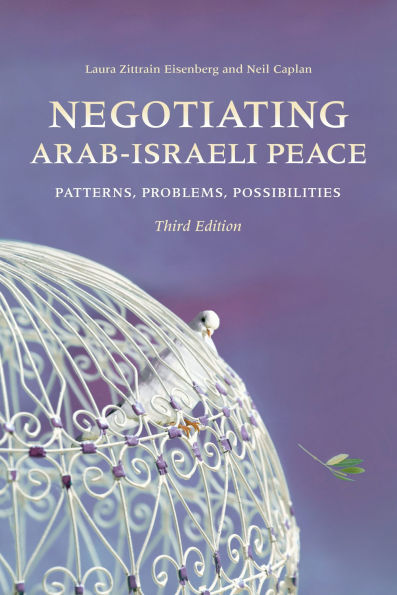
Negotiating Arab-Israeli Peace: Patterns, Problems, Possibilities
480
Negotiating Arab-Israeli Peace: Patterns, Problems, Possibilities
480Paperback(3rd ed.)
-
SHIP THIS ITEMAvailable for Pre-Order. This item will be released on March 4, 2025PICK UP IN STORE
Store Pickup available after publication date.
Available within 2 business hours
Related collections and offers
Overview
Laura Zittrain Eisenberg and Neil Caplan identify a specific pattern of negative negotiating behaviors that have historically stymied negotiators. The authors apply their original paradigm to six case studies, from the Camp David Accords to the Oslo agreements and the election of Benjamin Netanyahu, looking for characteristics that mirror or refute the tradition of failed diplomacy. By illuminating recurring factors that seem to doom peacemaking, Negotiating Arab-Israeli Peace offers a fresh interpretation of how, when, and why the peace process does and does not work and points to diplomatic strategies that may produce an enduring peace. A generous selection of primary documents and political cartoons contributes to this unique and thought-provoking presentation.

Product Details
| ISBN-13: | 9780253072559 |
|---|---|
| Publisher: | Indiana University Press |
| Publication date: | 03/04/2025 |
| Edition description: | 3rd ed. |
| Pages: | 480 |
| Product dimensions: | 6.00(w) x 9.00(h) x 0.00(d) |
About the Author
Neil Caplan is Scholar-in-Residence at Vanier College and Adjunct Assistant Professor of History at Concordia University, both in Montreal, Canada. He is author of Palestine Jewry and the Arab Question, 1917-1925, Futile Diplomacy, a four-volume study of Arab-Zionist and Arab-Israeli negotiations to 1956, and The Israel-Palestine Conflict: Contested Histories.
Table of Contents
List of Maps ix
Preface to the Second Edition xi
List of Abbreviations xv
Introduction. Historical Patterns: Bad Habits Are Hard to Break 1
Part 1 The Arab-Israeli Peace Process: Beginnings
1 Hot Wars and a Cold Peace: The Camp David Accords, 1977-1979 35
2 Mission Impossible: The 1983 Israel-Lebanon Agreement 52
3 Premature Peacemaking: The 1987 Hussein-Peres London Document 73
Part 2 The Arab-Israeli Peace Process: Madrid and After
4 Setting the Peace Table: The Madrid Conference and Washington Talks, 1991-1993 95
5 Out of the Shadows and into the Light: The Jordanian-Israeli Peace Process, 1991-1994 116
6 Falling Short of the Heights: Israel and Syria, 1991-2000 135
Part 3 The Israeli-Palestinian Peace Process: OSLO 1993 and Beyond
7 Breakthrough: The Oslo Accords 165
8 Breaking Down: Oslo Collapses 190
9 Broken beyond Repair? Camp David II and the Second Intifada 222
Conclusion. Peace as a Process 253
Epilogue. Rebuilding amid the Rubble 283
Appendix A Timeline 301
Appendix B Documents Online 311
Notes 317
Bibliography 381
Index 419
What People are Saying About This
One of the best presentations of how the Middle East not only can be but should be approached from a theoretical perspective.
No matter where one stands on the issues, this valuable work commends itself to students, peace makers, and anyone concerned about the Arab-Israeli conflict and its peaceful resolution. -- Institute for Palestine Studies
In separating the Arab-Israeli from the Palestinian-Israeli conflict, this second edition clarifies important differences in their nature, dyanmics, and degrees of intractability.
Nothing in my library comes close to Eisenberg and Caplan's unique and balanced treatment of the peace process. Their book is more essential today than when it was first published and contains many lessons that the parties could still benefit from.
This timely book. . .will be invaluable for students of Middle East international relations and for policy makers who seek a mutually acceptable resolution of this protracted conflict. -- McGill University
As with the first edition, the second edition of Negotiating Arab-Israeli Peace is extremely well-written. It covers the latest significant details in the negotiations and will be very useful as a resource for researchers and students alike.
In this second edition, Eisenberg (history, Carnegie Mellon Univ.) and Caplan (history, Concordia Univ., Canada) begin (as in the first edition) with an account of early-19th-century Arab-Jewish negotiations. They end with President Obama's belief that his vision of Middle Eastern peace is compatible with Muslim concerns and interests. The history of these peace efforts, they claim, reveals seven reoccurring areas of diplomatic difficulty, such as previous experience in negotiating, psychological factors affecting leaders and followers, and the role of third-party involvement. Several peace efforts, beginning with the Camp David Accords between Israel and Egypt in 1978 through the 1993 Oslo Accords, are examined in detail by considering these seven areas of difficulty. The authors assert that past peace negotiations failed to take into account one or more of the seven characteristics. Original chapters were updated and reflect new information and scholarship since the first edition 12 years ago. The new edition includes a 38-page bibliography and 125 related documents available online and coordinated with the text. A series of illustrative political cartoons is integrated throughout the text. Summing Up: Recommended. General readers, undergraduate students, graduate students, and research faculty. — Choice
